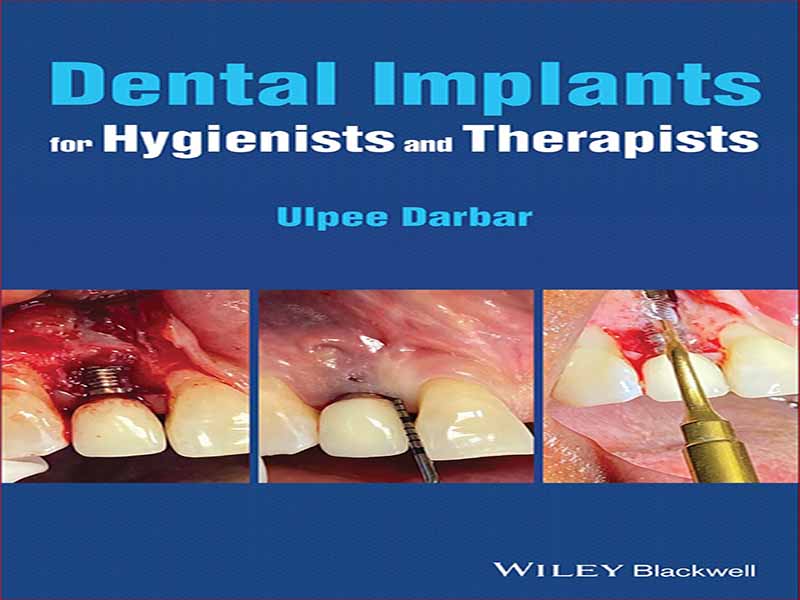- عنوان کتاب: Dental Implants for Hygienists and Therapists
- نویسنده: Ulpee-R.-Darbar
- حوزه: دندانپزشکی
- سال انتشار: 2022
- تعداد صفحه: 154
- زبان اصلی: انگلیسی
- نوع فایل: pdf
- حجم فایل: 18.8 مگابایت
مفهوم ایمپلنت دندان به 2000 سال قبل از میلاد برمی گردد، زمانی که گیره های حک شده بامبو در ابتدا برای جایگزینی دندان های از دست رفته استفاده می شد. ایمپلنت دندانی یک وسیله مصنوعی ساخته شده از مواد آلوپلاستیک است که در بافتهای دهان زیر مخاط و/یا لایه پریوستال و/یا داخل استخوان کاشته میشود تا از یک پروتز ثابت یا متحرک پشتیبانی کند. هنگامی که ایمپلنت ها در داخل استخوان قرار می گیرند، ایمپلنت های درون استخوانی نامیده می شوند. حدود 3000 سال پیش، مصری ها از گیره های فلزی برای جایگزینی دندان ها استفاده می کردند و تا دهه 1930، مفهوم ایمپلنتولوژی مدرن با توسعه تدریجی روش هایی که برای جایگزینی دندان های از دست رفته به کار می رفت، به وجود آمد. موادی که ایمپلنت های دندانی از آنها ساخته می شوند باید زیست سازگار، مقاوم در برابر خوردگی بوده و رشد استخوانی و عملکرد زیستی را تشویق کنند. در طول دهه 1939 تا 1960، مفهوم ایمپلنت “در استخوان” (اندوستئال) با اولین ایمپلنت پیچی استوانهای استوانهای جامد با رزوههای داخلی و خارجی با یقه لثهای صاف و کلاهک شفابخش مطرح شد. به دنبال آن در طول دهه 1940، یک ایمپلنت مارپیچی از جنس استنلس استیل پستی با طرحی که به استخوان اجازه رشد در ایمپلنت را می داد، ظاهر شد و دال در آلمان، تقریباً در همان زمان، مفهوم ایمپلنت زیر پریوستئال را با درج های مخاطی معرفی کرد. این ایمپلنت از کبالت-کروم مولیبدن ساخته شده بود که بر روی تاج برجستگی که برای ساختن پروتز گرفته شده بود، نقش مستقیمی بر روی آن ایجاد می شد. در طول دهه 1940-1950، تغییراتی در طرح اصلی دال در تلاش برای سادهتر کردن ایمپلنتها پدیدار شد و شامل استفاده از ایمپلنتهای ویتالیوم در سال 1948 بود، ایمپلنت دریچه تیغه درونی Linkow در سال 1966 با طرحهای مختلف برای فک بالا و فک پایین، ایمپلنت فریم راموس در سال 1970، ساخته شده از فولاد ضد زنگ و ایمپلنت ترانس استخوانی فک پایین که مرز پایینی فک پایین را با درج هایی که برای حمایت از پروتز به داخل دهان فرو می رود، درگیر می کرد. فریم راموس و ایمپلنتهای ترانوستئال عمدتاً برای بیماران مبتلا به فک پایین آتروفیک که در پوشیدن دندان مصنوعی مشکل داشتند طراحی شدهاند و برای کمک به حفظ دندان مصنوعی برای بهبود عملکرد استفاده میشوند.
The concept of dental implants dates as far back as 2000 BC when carved bamboo pegs were originally used to replace missing teeth. A dental implant is a prosthetic device made of alloplastic material implanted either into the oral tissues beneath the mucosal and/or the periosteal layer and/or within the bone to provide retention and support for a fixed or removable prosthesis. When inserted into the bone, the implants are called endo-osseous implants. Around 3000 years ago, Egyptians used metal pegs to replace teeth, and it was not until the 1930s the concept of modern implantology came into existence with progressive development of methods used to replace missing teeth. The materials from which dental implants are made should be biocompatible, corrosion resistant, and encourage bone ingrowth and biofunctionality. During 1939–60s the concept of the ‘in the bone’ (endosteal) implant arose with the first cylindrical endo-osseous solid screw implant with threads both internally and externally with a smooth gingival collar and healing cap being placed. Following this during the 1940s, a spiral stainless steel post type endosseous implant with a design that allowed bone to grow into the implant emerged and Dahl in Germany, around the same time, introduced the concept of the subperiosteal implant with mucosal inserts. This implant was made of cobalt-chromium molybedenum with a direct impression of the struts on the ridge crest taken to construct the denture. Throughout the 1940s–50s variations on the original Dahl design emerged in an attempt to make the provision of implants simpler and included the use of vitallium implants in 1948, the Linkow endoosseous blade vent implant in 1966 with different designs for the maxilla and mandible, the ramus frame implant in 1970, made of stainless steel and mandibular transossteal implant which engaged the lower border of the mandible with inserts projecting into the mouth to support a prosthesis. The ramus frame and tranossteal implants were predominantly designed for patients with atrophic mandibles who had difficulties wearing dentures and were used to aide denture retention to improve function.
این کتاب را میتوانید بصورت رایگان از لینک زیر دانلود نمایید.




































نظرات کاربران